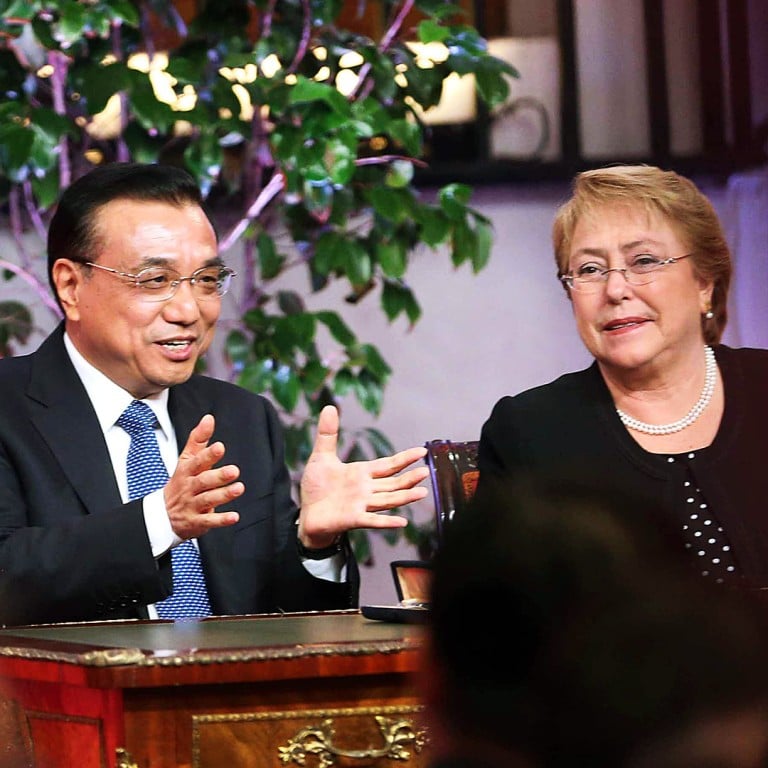
Chinese Premier Li Keqiang returns from South America with a caseful of deals
But analysts warn that while Beijing’s aid and investment – mainly in infrastructure and commodities extraction – will benefit the region, it remains largely tilted in China’s favour
Premier Li Keqiang was returning home from a Latin American tour on Tuesday with a briefcase full of deals that bolster a relationship profitable for the region’s slowing economies but still highly unequal.
On Monday, Li and Chilean President Michelle Bachelet signed a currency swap deal seeking to deepen economic ties by boosting trade and investment.
The currency swap agreement between Chile’s central bank and the People’s Bank of China eases the exchange of up to 2.2 trillion pesos (about US$3.6 billion) for the next three years. China has signed currency swap deals with several countries and has worked with financial centres to develop international hubs for offshore trading of the currency.
“We want to strengthen our financial cooperation with Chile during this visit, and we have both signed this swap deal,” the premier said during his visit to Chile, the last stop in his four-nation tour of South America, which also included Brazil, Colombia and Peru.
“I hope Chinese-Chilean cooperation can allow for services and guarantees that can firmly support our cooperation with all of Latin America.”
Watch: China to establish currency clearing bank in Chile
Li first official trip to Latin America comes as the continent feels the pinch of waning Chinese demand for its commodities.
His visit bore the most fruit in Brazil, where he sealed deals for US$53 billion in Chinese investment, mainly focused on upgrading the regional giant’s strained infrastructure.
He also made stops in Colombia, Peru and Chile on the nine-day tour.
The visit followed on President Xi Jinping’s visit last July to Brazil, Argentina, Venezuela and Cuba, underlining the Asian power’s role as a key trade partner for the region.
“Xi Jinping has been very clear about that in the past few months, that China will be contributing much more to the region, billions more to the region in the coming years, despite slowing growth on both sides of the Pacific,” said Margaret Myers, the director of the China and Latin America programme at the Inter-American Dialogue in Washington.
China extended more than US$119 billion in loans to Latin American countries and companies from 2005 to 2014, according to a report by the Inter-American Dialogue and Boston University.
Oil-rich Venezuela has been the biggest beneficiary, with US$56.3 billion, followed by Brazil with US$22 billion.
China, which is on track to displace the United States next year as Latin America’s largest trading partner, has devoured the region’s raw materials and natural resources, exporting manufactured goods in return.
The relationship is “still unbalanced,” said Myers, even if China is slowly starting to import finished goods.
“We see a lot of Chilean wine being exported, processed coffee, chocolate, a lot of value-added agriculture,” she said.
But that isn’t enough to redress the imbalance, said Alicia Barcena, head of the UN’s Economic Commission for Latin America and the Caribbean.
“Just five products, all commodities, accounted for 75 per cent of the value of regional sales to China in 2013,” she wrote in Spanish newspaper El Pais.
Some 90 per cent of Chinese investment in Latin America, meanwhile, went toward extracting natural resources, mainly mines and hydrocarbons, she said.
Falling commodities prices in recent years have made the lop-sided relationship more evident, hitting the brakes on Latin America’s economic growth.
Slowing growth in China now gives the two partners the chance to “deepen and broaden the relationship,” said Joao Augusto de Castro Neves, Latin America chief at consulting firm Eurasia Group.
For China, “their priorities are shifting from facilitating import of commodities to facilitating export of their industrial capacities,” he said.
“That explains their focus on infrastructure projects in Latin America,” where Chinese construction firms are keen to do more business, Castro Neves explained.
The most ambitious deal of Li’s tour was for a trans-Amazon railroad linking Peru and Brazil, enabling China to import Brazilian iron and soy for less money by shipping it across the Pacific.
“This new Chinese strategy converges with this greater urgency from Latin American countries to seek new investments and new sources of funding,” said Castro Neves.
But there will be “hurdles,” he predicted.
“The Chinese, we’ve seen their track record in Africa, for example. They tend to impose some unrealistic conditions when it comes to labour and the environment.”
Chinese projects in Argentina, Ecuador, Nicaragua and Peru have already faced protests.
In Nicaragua, farmers and environmentalists have been protesting for months against a Chinese firm’s ambitious US$50-billion project to build an interoceanic canal to rival Panama’s.
And in Peru, a worker was killed on Monday in clashes between police and protesting workers angry over “arbitrary” layoffs at a Chinese iron ore mine.
“As the Chinese presence continues to become more visible, there’s a certain discontent that will be felt more too,” said Carlos Malamud, a Latin America specialist at Spain’s Real Instituto Elcano think-tank.
A study carried out by universities in Argentina, Peru and the United States concluded that China’s increasing presence was “a major driver of environmental degradation in the region, and was also a source of significant social conflict”.
“The relationship with China is clearly beneficial for Latin America, but Latin Americans should be more careful at the negotiating table,” including by banding together to leverage their collective weight, Malamud said.
